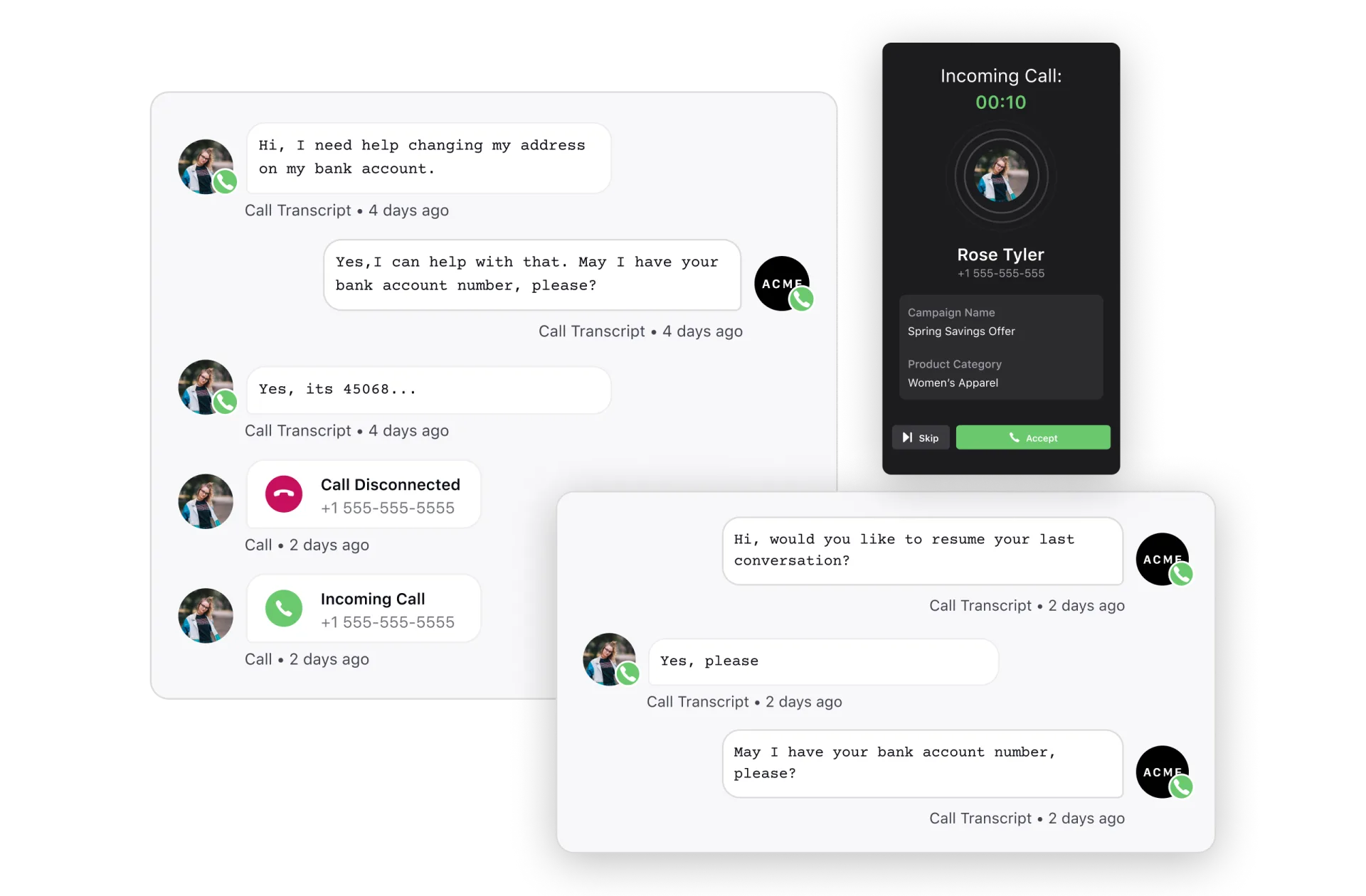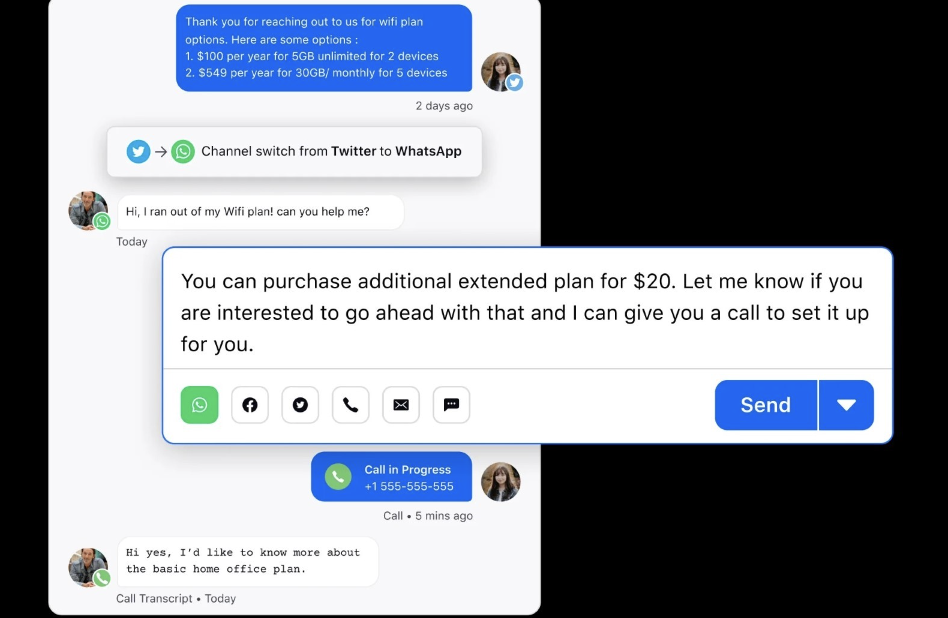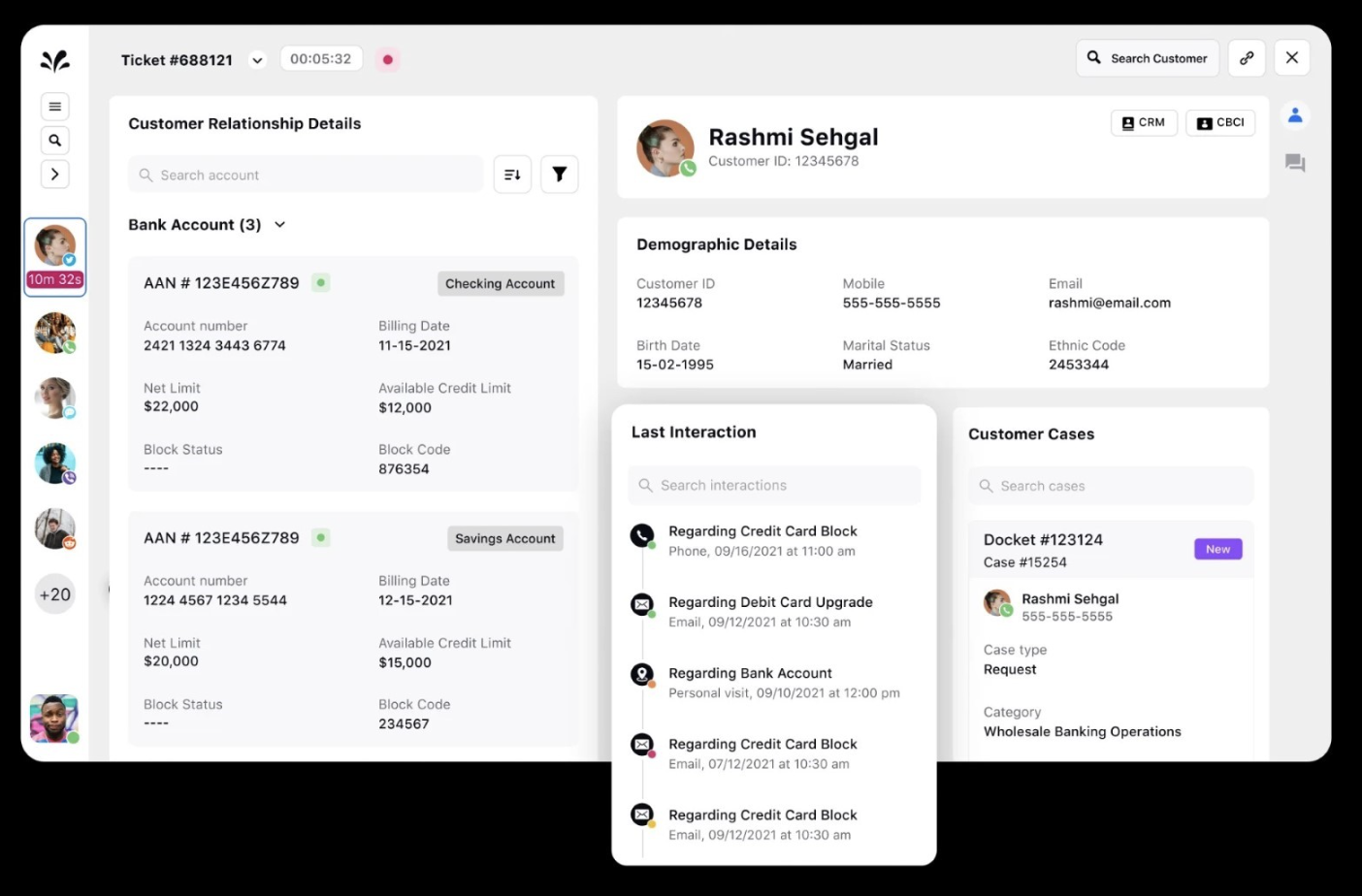What is conversational IVR?
Conversational IVR is a phone system feature that leverages a conversational AI platform to empower customers with self-service and agents with intelligent routing. Unlike traditional IVR systems that use Dual-tone-multi-frequency (DTMF) touch tones to navigate through call menus and submenus, conversational IVR engages callers using natural language. Callers can explain their pain points just as they would to human agents, making it a two-way communication that’s engaging as well as effective.
Conversational IVR leverages conversational AI technology to seek necessary inputs from callers and then give relevant responses, seek additional clarification or route them to live agents if necessary. While the objective of IVRs is to eliminate the need to talk to an agent conversational IVR keeps the option open in case of complex queries that warrant a human touch. In such cases, callers are directed to customer support agents with full context and case history, enabling speedy resolution and high customer satisfaction (CSAT).
Evolution of conversational IVR in customer service
The evolution of Interactive Voice Response (IVR) systems has been nothing short of remarkable. The journey began in the 1930s with the creation of the Voder machine, a pioneering venture by Homer Dudley of Bell Laboratories, aiming to synthesize human speech. Fast forward to the present day and we find ourselves in an era of Conversational IVR, where Artificial Intelligence (AI) is redefining customer experience. Looking through the six major pivots in the evolution of conversational IVR in brief:
Voder Machine sparked the AI speech synthesis revolution.
The sixties saw touch-tone tech give birth to IVR magic.
The 1970s unveiled accessible IVR melodies.
In the '90s, IVRs became a call center necessity, evolving with CTI and AI.
Tech evolution in the 2010s crafted modern IVRs mastering call dynamics.
Future harmony unfolds in the 2020s, spotlighting Conversational IVR brilliance.

Let’s talk about how Conversational IVR differs from traditional IVR and why you need to choose it.
Conversational IVR vs. traditional IVR
While standard IVR relies on rigid call flows and limited pre-recorded scripts, Conversational IVR is capable of delivering personalized responses. It evolves, getting smarter with each interaction, ensuring more accurate assistance, even for complex queries. Below are the key major differences between conversational IVR and traditional IVR.
Feature | Conversational IVR | Traditional IVR |
Response time | Provides instant response, focuses on self-service | Provides delayed response if agents are busy |
Language understanding | Natural Language Understanding, Machine Learning, Conversational AI | Natural Language Processing (Speech Recognition), Auto-Attendants |
Customer input | Inputs can be phrased in multiple ways, in full sentences, in different languages | Limited to pre-programmed trigger words/phrases, pre-recorded scripts |
Live agent involvement | Redirects to live agents when needed, passing along interaction data stores interaction data for improvement | Redirects to live agents if the request exceeds its limited scope, |
Support hours | Available for 24/7 real-time support | Support hours depend on live agent schedules |
Topic complexity | Provides support on nuanced and complex topics | Limited to basic predefined topics, keywords and phrases |
Learning and improvement | Becomes smarter/more accurate with every conversation due to Machine Learning | Limited learning, requires manual reprogramming and editing for updates |
Automation level | No-code automation reduces reliance on live agents | Updating responses is complex, involving re-programming, call flow editing and re-recording menu prompts |
Accuracy and relevance | High | Moderate |
How does conversational IVR work?
Conversational IVR utilizes advanced Conversational AI to process and respond to customer's voice commands in real-time. The objective is to create a personalized customer experience by understanding language, intent, context, sentiment and spoken responses.
It integrates key components like:
Natural Language Processing (NLP) to discern customer language
Natural Language Understanding (NLU) for evaluating intent in natural speech
Natural Language Generation (NLG) to deliver coherent responses
Below are five steps conversational IVR leverages to process conversations:
Interprets user requests: NLP identifies and translates the basic meaning of the customer's statement by determining the user’s language.
Analyzes user intent: NLU analyzes the intent behind the user's statement, allowing for a nuanced understanding of customer requests in their own words.
Generates spoken responses: NLG helps in generating spoken responses to customer queries, providing personalized and contextually relevant information.
Humanizes interactions: Conversational AI components work together to create human-like interactions. This enables customers to engage with the IVR system more naturally and intuitively.
Auto-updates algorithms: The use of Machine Learning ensures that Conversational IVR can adapt without manual updates or input. The system refines its algorithms based on customer interactions, making it a self-improving and efficient solution.
This comprehensive approach allows for dynamic, customer-friendly conversations, setting it apart in the realm of interactive voice response systems.
Also Read: How to Use Conversational AI for Customer Service
Key benefits of conversational IVR for businesses
The benefits a business can gain from Conversational IVR are aplenty, as it can play a vital role in enhancing phone support and overall customer service.
Benefit #1 - Natural two-way customer interaction
Conversational IVR allows users to express queries in full sentences, retaining context so users don't have to repeat information if they get transferred to a different department or if the conversation is interrupted. This personalized approach contrasts with the rigid, menu-driven interactions of standard IVR, resulting in improved digital customer experience.

Benefit #2 - Cost efficiency
Conversational IVR drastically reduces customer support costs, with an average of $0.10 per contact compared to $8.01 for live support. The system provides 24/7 real-time support without the need for additional agent hiring, allowing existing staff to focus on sales and productivity.

Benefit #3 - Customer-first support
Conversational IVR complements omnichannel customer service, offering an intuitive, fast and personalized support experience. It guides customers to their preferred communication channels and self-service resources for faster issue resolutions. It reduces average handle times, boosting customer satisfaction (CSAT).

Benefit #4 - Faster response rates
Conversational IVR eliminates lengthy pre-recorded menus, providing customers with direct control over the call direction. Automated responses are concise, allowing customers to easily interrupt and request live agent assistance. This approach significantly increases first-contact resolution rates, enhancing overall efficiency.
Benefit #5 - Scalable and multilingual
With multilingual support, conversational IVR accommodates diverse customer preferences, contributing to international scalability. This feature is crucial for businesses looking to expand into new markets, ensuring effective communication with customers in their native language.
Benefit #6 - Real-time data utilization
Conversational IVR integrates with contact center CRM systems, utilizing real-time customer data to personalize interactions. This dynamic response to customer information contrasts with the static and often impersonal nature of standard IVR interactions.

Benefit #7 - Accurate routing
Conversational IVR optimizes call prioritization through contextual cues, utilizing the Intent engine to ensure precise call routing and connect each inquiry with the most adept agent available leveraging skill-based routing.
Also Read: Top 15 Benefits of IVR
9 steps to implement conversational IVR
Implementing Conversational IVR involves a strategic and well-thought-out process to ensure its effectiveness in meeting the specific needs of a contact center. Below are the steps to implement Conversational IVR:
1. Define your objectives
Clearly identify the key objectives of implementing Conversational IVR. This includes improving customer satisfaction, reducing average hold times and increasing self-service rates. Align these objectives with broader business objectives and customer service goals.
2. Identify use cases
Determine the specific use cases where Conversational IVR will be most beneficial. Prioritize high-volume and easily automated inquiries, such as payment assistance, product information retrieval and appointment setting.
3. Map out the conversational flow
Map out the expected dialog between customers and the system based on identified use cases. Define likely user inputs, system responses and potential conversation paths. Use historical call data and transcripts for insights.
💡Pro tip: Crafting workflows for every customer support scenario can be time-consuming. Today, there are generative AI-enriched platforms like Sprinklr AI+ that can extract insights from unstructured conversations your customers are having on the web and then, build workflows from them. |
4. Implement NLP and speech recognition
Choose a reliable Natural Language Processing (NLP) and speech recognition platform to power the system. This step is crucial for enabling the AI capabilities required for processing conversational communication.
5. Best UI practices
Keep the language natural, reflecting human conversation. Provide clear prompts and options to avoid confusion. Focus on personalization and context by leveraging customer data.
6. Test and optimize
Treat Conversational IVR as an ongoing project requiring regular testing and optimization. Gather real-world feedback to adapt NLP models and conversational flows. Consider working with a futuristic tech partner who understands the latest IVR trends and is capable of engineering self-learning AI models for maintenance and updates.
7. Measure performance
Assess key performance indicators (KPIs) such as customer self-service success rate, average handling time, user satisfaction scores and transfer rates. Generate regular reports to track system performance and identify areas for improvement.
8. Collect user feedback
Utilize IVR-delivered customer surveys to collect user feedback. This method helps identify pain points and address any minor flaws in the IVR solution, contributing to ongoing improvement.
9. Regular updates and enhancements
Leverage modern cloud technology to roll out regular updates and keep the IVR system current. Adapt to changing customer behavior and operational challenges using feedback and natural language data.
Expect advancements in complex query handling, multilingual support, integration with AI assistants like Siri and Alexa, and the potential use of voice biometrics for authentication and personalized interactions.
Interesting Read: 3-step Conversational AI Strategic Framework
Conversational IVR use cases with promising business results
Adopting conversational IVR can be one the best upgrades you could do in 2024 to handle your call volume efficiently. It’s an incredible investment with an equally impressive ROI.
boAt is one of the largest audio and tech wearable brands in India. They firmly believe,
To give customers what they want, we need to continuously listen to what's happening out there in the market. What are our consumers generally talking about? What features are they looking for in a product?
Challenge:
To achieve this very objective they were determined to create a seamless end-to-end customer experience, efficiently identifying and resolving customer issues. Two major challenges they faced were:-
Customers with D2C types of queries had to wait in long queues
The IVR had limited capabilities
Solution They deployed Sprinklr Service and with the help of its conversational IVR scaled up their self-serve and improved their decision-making through comprehensive reporting and analysis.
Result
2.4 million phone calls managed by IVR without going to an agent with 1.5 Mn leveraging only on D2C workflow saving an astounding 16,000 agent days. It also increased their CSAT score to a staggering 87%.
Read the complete story on how boAt keeps customers at the heart of its business with Sprinklr Service. If you want to replicate boAt’s success and manage exploding call volumes with ease, deploy Sprinklr AI+ and Conversational IVR software.
Experience Sprinklr Service today and see the difference for yourself.
Frequently Asked Questions
related products
Thank you for contacting us.
A Sprinklr representative will be in touch with you shortly.
Contact us today, and we'll create a customized proposal that addresses your unique business needs.
Request a Demo
Welcome Back,
No need to fill out any forms — you're all set.



